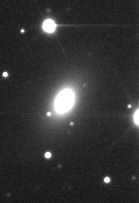
The galaxy UGC 4170
MODELISATION BY ADJUSTING ELLIPSES
We describe a performant tool for modeling and photometric analysis of extended object like galaxies and comets. For exemple this command is intended to model elliptical galaxies in order to study their morphology and their deviation from ellipticity. The morphological analysis is based on determining the parameters of elliptical isophotes from measurements of second order moments of inertia, for each real isophote. Higher order moments of inertia are also measured in order to determine the value of the coefficients (a3,b3,...a6,b6) associated with each isophote. These coefficients are defined by the Fourier series expansion of the deviations dr from the elliptical contour calculated for each real isophote:
dr = a3.cos(3.a) + b3.sin(3.a) + ... + a6.cos(6.a) + b6.sin(6.a)
where a is the azimuth angle.
Note that this analysis is adapted to objects with exponentially decreasing luminosity from the center, for example, elliptical galaxies.
Exemple, load the image U4170 from the console (click here for download the image of the elliptical galaxy UGC 4170, size = 20Kb):
LOAD U4170
VISU 560 370

The galaxy UGC 4170
Run the command Fit ellipses from the Processing menu, then enter the following parameters:
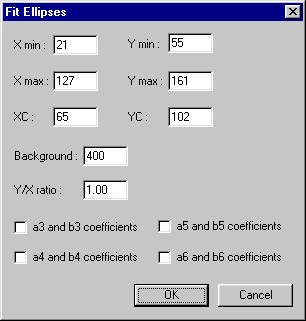
For each analysis, the ASCII file ELLIPSE.LST is generated. The lines of this file give the characteristics of an ellipse starting from the center of the object. The column contains the following information:
Note that:
- a galaxy with a4>0 is called 'disky'
- a galaxy with a4<0 is called 'boxy'
- a galaxy with a6>0 is called 'lemon'
Click OK. The result image contains the model of the galaxy. The file ELLIPSE.LST contains the numerical output of the analysis.
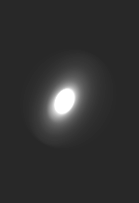
The numerical model of
UGC 4170
At this stage, to know if the modeling is correct, it is useful to subtract the model from the original image:
SAVE R
LOAD U4170
SUB R 100
VISU 150 80
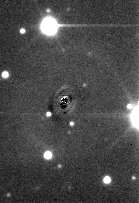
The difference of the
original image and the model.
The image of the galaxy has pretty much disappeared. Only the stars remain., The concentric central zone comes from calculation artefacts and is thus not real. Note also a dark arc near the star at (50,90). This is also an artefact of the calculation. To verify this, we recommend that you suppress this star in the original image and then re-start the processing. For this use the SUBSTITUTE command. This allows you to compare, pixel by pixel, the original image and the first model of this image. Any pixel on the original image outside a given threshold will be replaced by its equivalent in the model. If the threshold is well chosen, the pixels on the original image that have the level of stars will be given the value from the model, and thus eliminated.
Be careful, however; if the threshold is too low, you may suppress details in the image that can be modeled. If the threshold is too high, the stars may not be attenuated. The right balance can be found by trial and error.
For the image UGC 4170 and its first model, we have chosen the threshold value 30 (see the SUBSTITUTE command). We write:
SUBSTITUTE U4170 R 30
SAVE R2
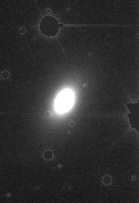
Result of the SUBSTITUTE
command (R2 image).
There are only faint marks where the stars were (see also the command SYM very usefull for situations of this type).. We can now iterate with fit ellipse algorithm, this time on the image R2.PIC:
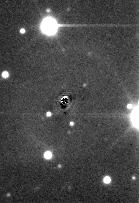
Difference from the original
image (U4170) and the model synthetised with R2 image.
The artefacts are definitely attenuated.
Now, let's look at the galaxy UGC 4367 (click here for download U4367 image, size = 20Kb):
LOAD U4367
VISU 450 180
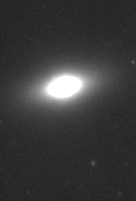
The UGC 4367 galaxy.
We will process this galaxy with the parameters:
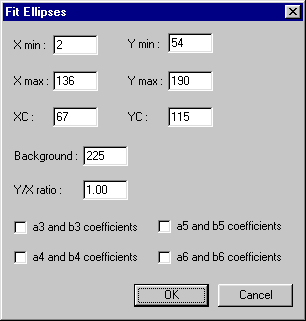
A cross shaped residual is clearly visible. This is because UGC 4367 is a typical "disky" galaxy:
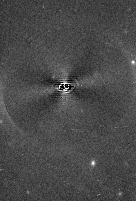
Residual of the modeling
for UGC 4367.
We should redo the model, taking into account the coefficients a4 and b4 (reload the image before):
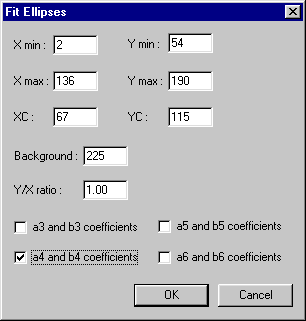
This time, the result is very satisfying. Note in particular the presence of faint stars that appear in front of the galaxy. They would have been invisible if the galaxy had not been removed:
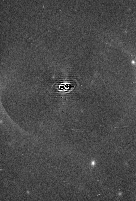
A good fit for the model.
In general, calculating a model for a galaxy, then subtracting this model, can bring out less visible structures - globular clusters, shells, supernovae. It is also usefull for detection of faint structures in coma of comets.